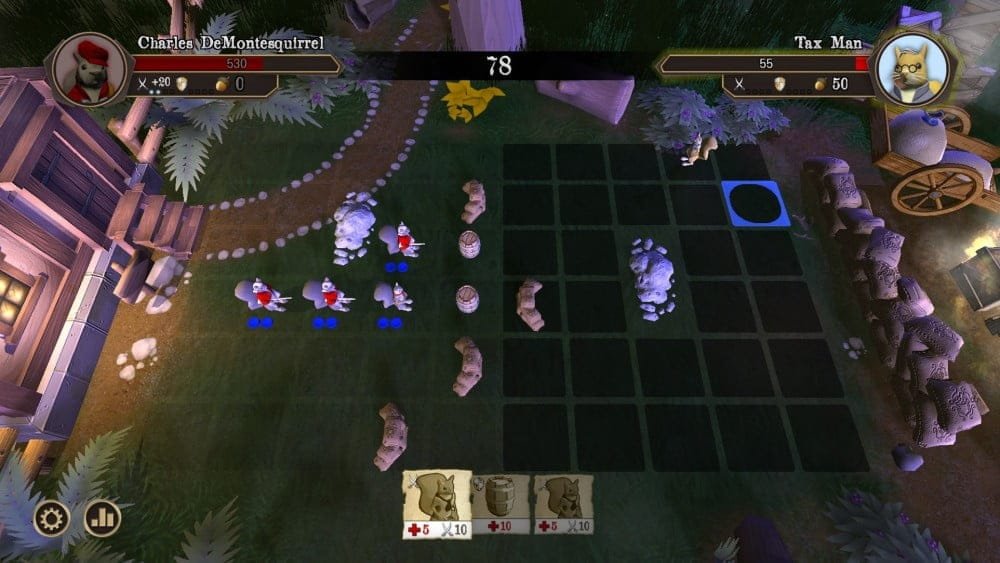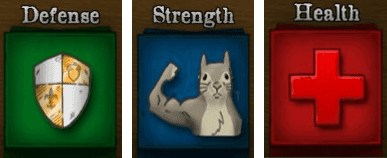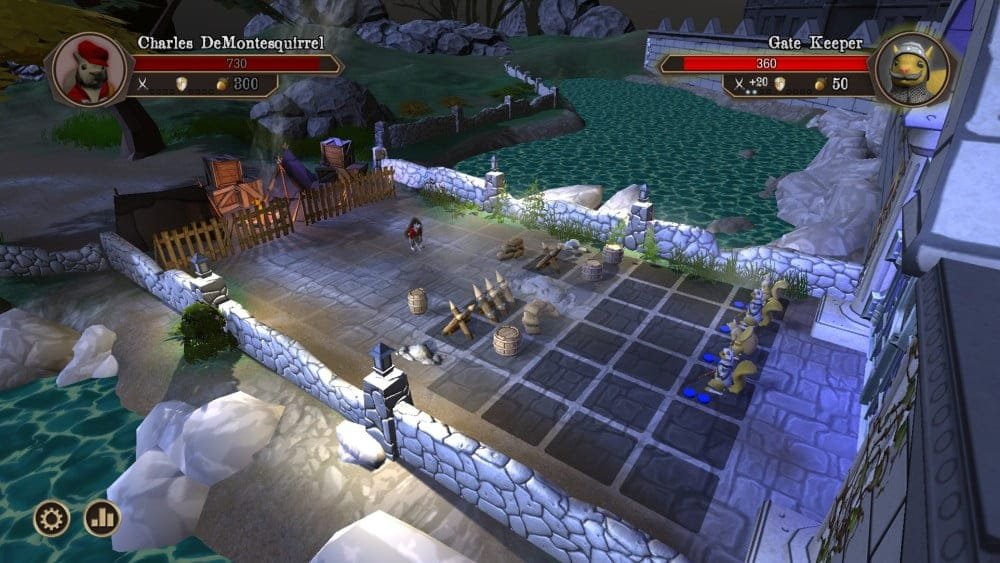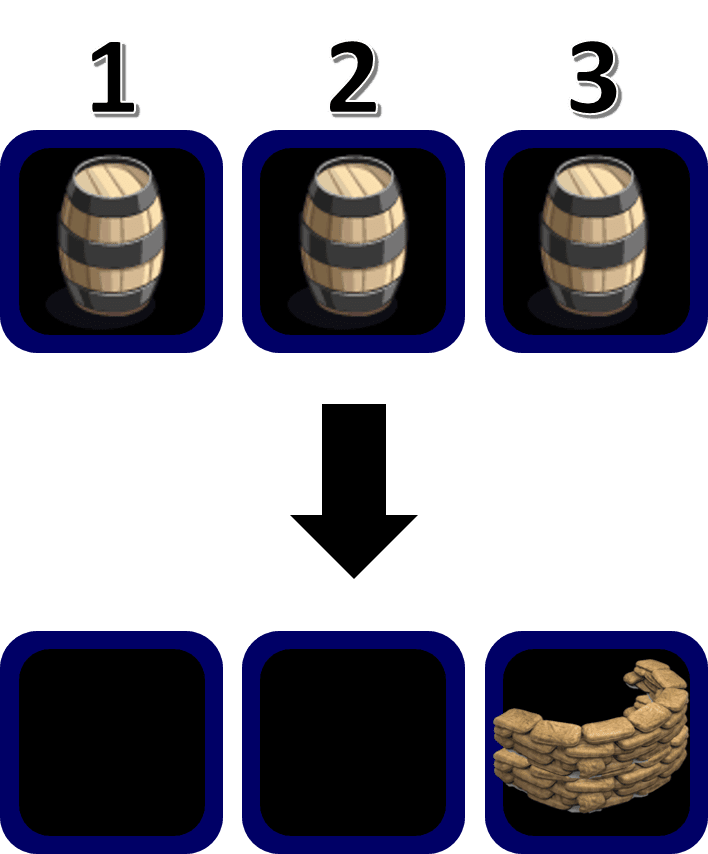 Adapting board games to electronic platforms is a hit-and-miss operation. Classic titles that have been around for decades are especially difficult. Often the rules quite don’t translate, and developers are slow to release expansion boards, card sets, and game pieces in the form of DLC. Fortunately, the game we’re about to review doesn’t have to worry about any of that because it’s unique to the computerized world! Enter Acorn Assault: Rodent Revolution, developed by High Tale Studios and published by Black Shell Media.
Adapting board games to electronic platforms is a hit-and-miss operation. Classic titles that have been around for decades are especially difficult. Often the rules quite don’t translate, and developers are slow to release expansion boards, card sets, and game pieces in the form of DLC. Fortunately, the game we’re about to review doesn’t have to worry about any of that because it’s unique to the computerized world! Enter Acorn Assault: Rodent Revolution, developed by High Tale Studios and published by Black Shell Media.
Fans will tell you that to be a good board game, a title must provide a balance of two features: strategy and tactics. The former represents an overall plan that defines a player’s future intentions. The latter denotes a specific pro-action to embellish that plan or a reaction to an opponent’s move.
 The idea behind Acorn Assault: Rodent Revolution is simple enough. You are a rebel squirrel during the French Revolution, doing your part to end the tyranny brought on by the tax-collecting authority. Acorns are your currency, and your fellow squirrels are being denied their share. Vive la Revolution!
The idea behind Acorn Assault: Rodent Revolution is simple enough. You are a rebel squirrel during the French Revolution, doing your part to end the tyranny brought on by the tax-collecting authority. Acorns are your currency, and your fellow squirrels are being denied their share. Vive la Revolution!
The game plays out on a grid somewhat like a chess board. You place gun-wielding squirrels onto squares on your side of the board, along with obstacles and barricades to slow the Tax Man’s army. You place your pieces and attack first each round before the enemy has a chance to do the same. To compensate, your opponent is granted a larger corps of defenders to use on the first turn (and on subsequent turns if they survive). This defensive advantage becomes more pronounced as the game progresses, so your thought processes must evolve, as well.
 Stationed behind each team of combatants is a base of operations. This is shown as a house, gate, or some other solid structure, depending on the current place in the story. The goal of each round is to destroy the enemy base, and it turns out that your base always begins with more hit points than that of the AI. Don’t be fooled, however. The opponent’s aforementioned corps advantage more than makes up for its slightly weaker base. Trust me, you’ll appreciate every last hit point you have!
Stationed behind each team of combatants is a base of operations. This is shown as a house, gate, or some other solid structure, depending on the current place in the story. The goal of each round is to destroy the enemy base, and it turns out that your base always begins with more hit points than that of the AI. Don’t be fooled, however. The opponent’s aforementioned corps advantage more than makes up for its slightly weaker base. Trust me, you’ll appreciate every last hit point you have!
The rules of play remain more or less the same throughout the story, so we’ll examine the most common strategic and tactical elements for this review.
First, the strategy:
 When a round begins, you’re presented with a 5-item lineup. This consists of “3 barrels plus 2 squirrels” or “3 squirrels plus 2 barrels”. Either way, you have these 5 objects to place onto the board as you see fit. Squirrels represent your offensive force, while barrels provide a protective defense. Truth be told, squirrels do have a small number of hit points themselves, so they can be used as defensive structures to protect your base.
When a round begins, you’re presented with a 5-item lineup. This consists of “3 barrels plus 2 squirrels” or “3 squirrels plus 2 barrels”. Either way, you have these 5 objects to place onto the board as you see fit. Squirrels represent your offensive force, while barrels provide a protective defense. Truth be told, squirrels do have a small number of hit points themselves, so they can be used as defensive structures to protect your base.
 Before placing your pieces, look for piles of acorn currency that periodically show up on the board. Placing either a squirrel or a barrel onto the acorns increases your bank reserves. What can you spend acorns on? Three things:
Before placing your pieces, look for piles of acorn currency that periodically show up on the board. Placing either a squirrel or a barrel onto the acorns increases your bank reserves. What can you spend acorns on? Three things:
 Defense: Increases the amount of damage your squirrels absorb from enemy fire.
Defense: Increases the amount of damage your squirrels absorb from enemy fire.
Strength: Increases your squirrels’ attack damage.
Health: Restores hit points to your base of operations.
One thing to remember is that you’re not obligated to claim or spend acorns on the round they appear. In other words, you don’t have to sacrifice good piece placement for currency. Acorns left on the board will remain in place for the next round. Especially in later stages, large bank reserves become critical for victory. Now, this doesn’t mean you can bilk the system by “squirreling away” all your nuts; the Tax Man collects a nominal percentage of your bank at the start of every round! Unfair? Perhaps. But with patience, you’ll figure out your opponent’s methods, beat the rounds, and advance the story.
Now for the tactics:
Placing three like objects adjacent to each other (either in a straight line or in an “L” shape) causes them to combine into a single, tougher object. So three “pistol squirrels” combine to form a single “rifle squirrel”. Three “barrels” combine to form a single “sand barrier”. These advanced objects can be combined even further (three “sand barriers” become a “wood barrier”, etc.). Each time you combine items in this way, additional acorns are added to your bank.
A word of caution when combining objects: The upgraded item will not automatically appear on the center square, but rather on the square that received the “third” item. In the image below for example, the sand barrier has replaced all three barrels, and it has appeared in the square where the barrel marked “3” was originally placed:
 Mechanics like these are what makes this game enjoyable because they’re easy to understand, yet not easily mastered. The fact that you can replace the enemy AI with an actual human opponent helps to justify the title’s not-quite-bargain price. I would suggest adding Steam achievements, as these often tip the purchasing scale to the positive side. Also, a way to adjust the game’s difficulty would be useful. As it stands, it’s a bit too hard. Though the AI’s base has fewer hit points, its corps bonus is OP and can be frustrating to overcome.
Mechanics like these are what makes this game enjoyable because they’re easy to understand, yet not easily mastered. The fact that you can replace the enemy AI with an actual human opponent helps to justify the title’s not-quite-bargain price. I would suggest adding Steam achievements, as these often tip the purchasing scale to the positive side. Also, a way to adjust the game’s difficulty would be useful. As it stands, it’s a bit too hard. Though the AI’s base has fewer hit points, its corps bonus is OP and can be frustrating to overcome.
So overall, is Acorn Assault: Rodent Revolution worth it? Priced on Steam at $15 (USD), the answer is yes. Despite its difficulty, you’ll find yourself wanting “One more round…just one more round!” Have fun balancing all the elements of this well-thought-out, board game-style slug-fest…and go nuts!
-Chris Roberts-

I’m an autistic gamer with ADHD, studying Business Administration at the University of the People while learning game development. For over 10 years, I’ve reviewed games, collaborated on projects at global game jams, and attended industry conferences. I love growing with others through our shared passion. Always learning, always pushing forward — sometimes you just have to do something crazy.
